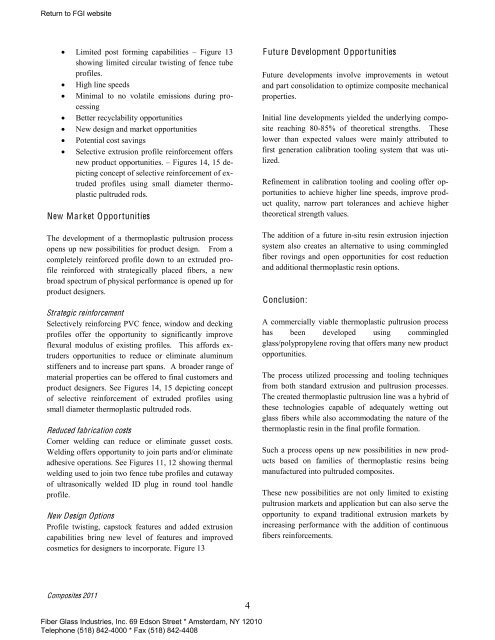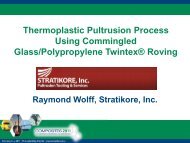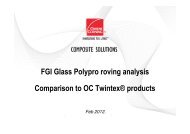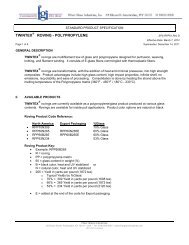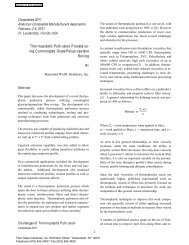Thermoplastic Pultrusion Process using commingled glass ...
Thermoplastic Pultrusion Process using commingled glass ...
Thermoplastic Pultrusion Process using commingled glass ...
You also want an ePaper? Increase the reach of your titles
YUMPU automatically turns print PDFs into web optimized ePapers that Google loves.
Return to FGI website<br />
Limited post forming capabilities Figure 13<br />
showing limited circular twisting of fence tube<br />
profiles.<br />
High line speeds<br />
Minimal to no volatile emissions during processing<br />
Better recyclability opportunities<br />
New design and market opportunities<br />
Potential cost savings<br />
Selective extrusion profile reinforcement offers<br />
new product opportunities. Figures 14, 15 depicting<br />
concept of selective reinforcement of extruded<br />
profiles <strong>using</strong> small diameter thermoplastic<br />
pultruded rods.<br />
New Market Opportunities<br />
The development of a thermoplastic pultrusion process<br />
opens up new possibilities for product design. From a<br />
completely reinforced profile down to an extruded profile<br />
reinforced with strategically placed fibers, a new<br />
broad spectrum of physical performance is opened up for<br />
product designers.<br />
Strategic reinforcement<br />
Selectively reinforcing PVC fence, window and decking<br />
profiles offer the opportunity to significantly improve<br />
flexural modulus of existing profiles. This affords extruders<br />
opportunities to reduce or eliminate aluminum<br />
stiffeners and to increase part spans. A broader range of<br />
material properties can be offered to final customers and<br />
product designers. See Figures 14, 15 depicting concept<br />
of selective reinforcement of extruded profiles <strong>using</strong><br />
small diameter thermoplastic pultruded rods.<br />
Reduced fabrication costs<br />
Corner welding can reduce or eliminate gusset costs.<br />
Welding offers opportunity to join parts and/or eliminate<br />
adhesive operations. See Figures 11, 12 showing thermal<br />
welding used to join two fence tube profiles and cutaway<br />
of ultrasonically welded ID plug in round tool handle<br />
profile.<br />
New Design Options<br />
Profile twisting, capstock features and added extrusion<br />
capabilities bring new level of features and improved<br />
cosmetics for designers to incorporate. Figure 13<br />
Composites 2011<br />
Fiber Glass Industries, Inc. 69 Edson Street * Amsterdam, NY 12010<br />
Telephone (518) 842-4000 * Fax (518) 842-4408<br />
4<br />
Future Development Opportunities<br />
Future developments involve improvements in wetout<br />
and part consolidation to optimize composite mechanical<br />
properties.<br />
Initial line developments yielded the underlying composite<br />
reaching 80-85% of theoretical strengths. These<br />
lower than expected values were mainly attributed to<br />
first generation calibration tooling system that was utilized.<br />
Refinement in calibration tooling and cooling offer opportunities<br />
to achieve higher line speeds, improve product<br />
quality, narrow part tolerances and achieve higher<br />
theoretical strength values.<br />
The addition of a future in-situ resin extrusion injection<br />
system also creates an alternative to <strong>using</strong> <strong>commingled</strong><br />
fiber rovings and open opportunities for cost reduction<br />
and additional thermoplastic resin options.<br />
Conclusion:<br />
A commercially viable thermoplastic pultrusion process<br />
has been developed <strong>using</strong> <strong>commingled</strong><br />
<strong>glass</strong>/polypropylene roving that offers many new product<br />
opportunities.<br />
The process utilized processing and tooling techniques<br />
from both standard extrusion and pultrusion processes.<br />
The created thermoplastic pultrusion line was a hybrid of<br />
these technologies capable of adequately wetting out<br />
<strong>glass</strong> fibers while also accommodating the nature of the<br />
thermoplastic resin in the final profile formation.<br />
Such a process opens up new possibilities in new products<br />
based on families of thermoplastic resins being<br />
manufactured into pultruded composites.<br />
These new possibilities are not only limited to existing<br />
pultrusion markets and application but can also serve the<br />
opportunity to expand traditional extrusion markets by<br />
increasing performance with the addition of continuous<br />
fibers reinforcements.


